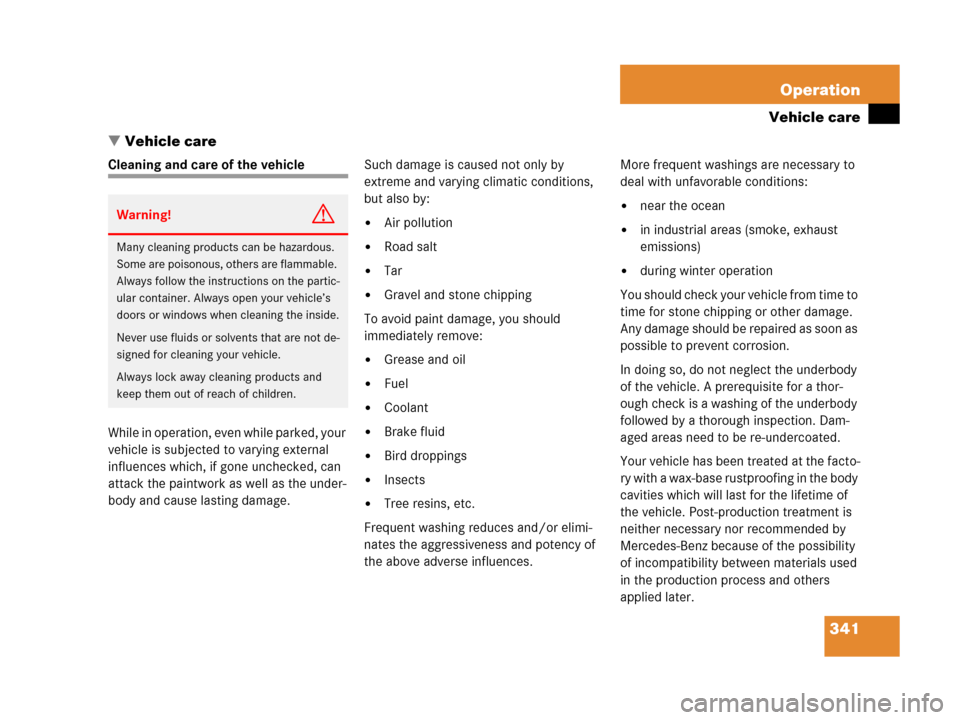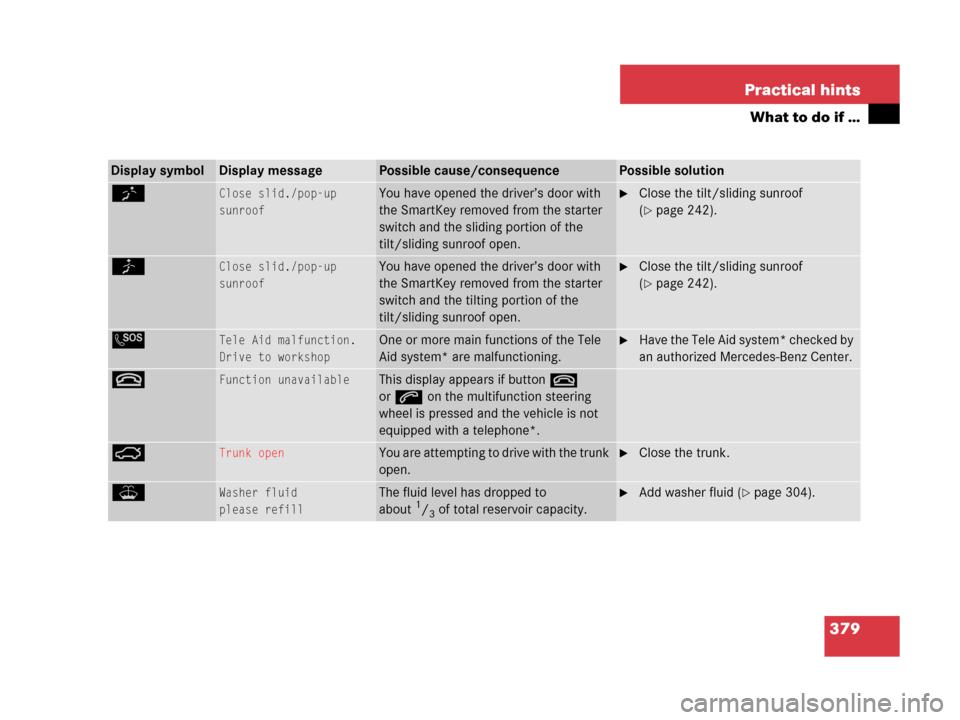Page 249 of 473
248 Controls in detail
Loading
Roof rack*
�Mount the roof rack only between the
fastening points (see arrows).
�Secure the roof rack according to
manufacturer’s instructions for
installation.
Warning!G
Only use roof racks approved by
Mercedes-Benz for your vehicle model to
avoid damage to the vehicle.
Follow the manufacturer’s installation in-
structions. Otherwise, an improperly at-
tached roof rack system or its load could
become detached from the vehicle.
Do not exceed the maximum roof load of
220 lb (100 kg).
Take into consideration that when the roof
rack is loaded, the handling characteristics
are different from those when operating the
vehicles without the roof rack loaded.
!
Load the roof rack in such a way that
the vehicle cannot be damaged while
driving.
Make sure
�you can fully raise the tilt/sliding
sunroof.
�you can fully open the trunk.
Page 284 of 473

283 Operation
Driving instructions
�Driving instructions
Drive sensibly – save fuel
Fuel consumption, to a great extent,
depends on driving habits and operating
conditions.
To save fuel you should:
�Keep tires at the recommended tire
inflation pressures.
�Remove unnecessary loads.
�Remove roof rack when not in use.
�Allow engine to warm up under low
load use.
�Avoid frequent acceleration and decel-
eration.
�Have all maintenance work performed
at the intervals specified in the
Maintenance Booklet and as required
by the maintenance service display.
Contact an authorized Mercedes-Benz
Center.
Fuel consumption is also increased by
driving in cold weather, in stop-and-go
traffic, on short trips and in hilly area.
Drinking and drivingPedals
Power assistance
Warning!G
Drinking and driving and/or taking drugs
and driving are very dangerous combina-
tions. Even a small amount of alcohol or
drugs can affect your reflexes, perceptions
and judgment.
The possibility of a serious or even fatal
accident are greatly increased when you
drink or take drugs and drive.
Do not drink or take drugs and drive or allow
anyone to drive who has been drinking or
taking drugs.
Warning!G
Make sure that absolutely no objects are ob-
structing the pedals’ range of movement.
Keep the driver’s footwell clear of all obsta-
cles. If there are any floormats or carpets in
the footwell, make sure that the pedals still
have sufficient clearance.
Warning!G
With the engine not running, there is no
power assistance for the brake and steering
systems. In this case, it is important to keep
in mind that a considerably higher degree of
effort is necessary to brake and steer the
vehicle.
Page 334 of 473

333 Operation
Tires and wheels
Maximum tire inflation pressure
This number is the greatest amount of air
pressure that should ever be put in the tire
under normal driving conditions.
Normal occupant weight
The number of occupants the vehicle is
designed to seat, multiplied by
68 kilograms (150 lbs).
Occupant distribution
The distribution of occupants in a vehicle
at their designated seating positions.Production options weight
The combined weight of those installed
regular production options weighing over
5 lbs (2.3 kilograms) in excess of those
standard items which they replace, not
previously considered in curb weight or
accessory weight, including heavy duty
brakes, ride levelers, roof rack, heavy duty
battery, and special trim.
PSI (P
ounds per square inch)
A standard unit of measure for air pressure
-> bar, kilopascal (kPa).
Recommended tire inflation pressure
Recommended tire inflation pressure
listed on placard located on driver’s door
B-pillar for normal driving conditions.
Provides best handling, tread life and
riding comfort.Rim
A metal support for a tire or a tire and tube
assembly upon which the tire beads are
seated.
Sidewall
The portion of a tire between the tread and
the bead.
TIN (Tire Identification Number)
Unique identifier which facilitates efforts
by tire manufacturers to notify purchasers
in recall situations or other safety matters
concerning tires and gives purchases the
means to easily identify such tires. The TIN
is comprised of “Manufacturer’s identifica-
tion mark”, “Tire size”, “Tire type code”
and “Date of manufacture”.
Page 342 of 473

341 Operation
Vehicle care
�Vehicle care
Cleaning and care of the vehicle
While in operation, even while parked, your
vehicle is subjected to varying external
influences which, if gone unchecked, can
attack the paintwork as well as the under-
body and cause lasting damage.Such damage is caused not only by
extreme and varying climatic conditions,
but also by:
�Air pollution
�Road salt
�Tar
�Gravel and stone chipping
To avoid paint damage, you should
immediately remove:
�Grease and oil
�Fuel
�Coolant
�Brake fluid
�Bird droppings
�Insects
�Tree resins, etc.
Frequent washing reduces and/or elimi-
nates the aggressiveness and potency of
the above adverse influences.More frequent washings are necessary to
deal with unfavorable conditions:
�near the ocean
�in industrial areas (smoke, exhaust
emissions)
�during winter operation
You should check your vehicle from time to
time for stone chipping or other damage.
Any damage should be repaired as soon as
possible to prevent corrosion.
In doing so, do not neglect the underbody
of the vehicle. A prerequisite for a thor-
ough check is a washing of the underbody
followed by a thorough inspection. Dam-
aged areas need to be re-undercoated.
Your vehicle has been treated at the facto-
ry with a wax-base rustproofing in the body
cavities which will last for the lifetime of
the vehicle. Post-production treatment is
neither necessary nor recommended by
Mercedes-Benz because of the possibility
of incompatibility between materials used
in the production process and others
applied later.
Warning!G
Many cleaning products can be hazardous.
Some are poisonous, others are flammable.
Always follow the instructions on the partic-
ular container. Always open your vehicle’s
doors or windows when cleaning the inside.
Never use fluids or solvents that are not de-
signed for cleaning your vehicle.
Always lock away cleaning products and
keep them out of reach of children.
Page 380 of 473

379 Practical hints
What to do if …
Display symbolDisplay messagePossible cause/consequencePossible solution
KClose slid./pop-up
sunroofYou have opened the driver’s door with
the SmartKey removed from the starter
switch and the sliding portion of the
tilt/sliding sunroof open.�Close the tilt/sliding sunroof
(
�page 242).
JClose slid./pop-up
sunroofYou have opened the driver’s door with
the SmartKey removed from the starter
switch and the tilting portion of the
tilt/sliding sunroof open.�Close the tilt/sliding sunroof
(
�page 242).
LTele Aid malfunction.
Drive to workshopOne or more main functions of the Tele
Aid system* are malfunctioning.�Have the Tele Aid system* checked by
an authorized Mercedes-Benz Center.
tFunction unavailableThis display appears if buttont
ors on the multifunction steering
wheel is pressed and the vehicle is not
equipped with a telephone*.
ÊTrunk openYou are attempting to drive with the trunk
open.�Close the trunk.
WWasher fluid
please refillThe fluid level has dropped to
about1/3of total reservoir capacity.
�Add washer fluid (�page 304).
Page 390 of 473
389 Practical hints
Opening/closing in an emergency
�Opening/closing in an emergency
Power tilt/sliding sunroof
You can open or close the tilt/sliding
sunroof manually should an electrical
malfunction occur.
The tilt/sliding sunroof drive is located
behind the lens1 of the interior overhead
light.
1Lens
�Remove SmartKey from the starter
switch.
�Pry off lens1 using a flat blade
screwdriver.2Locking tabs
�Slide both locking tabs2 in direction
of the arrows.
�Lower the rear of the cover and
remove.
�Remove the cover.
�Take the crank3 out of the Operator’s
Manual pouch.3Crank
�Insert crank3 through hole on the left
side.
�Turn crank3 clockwise to:
�slide sunroof closed
�raise sunroof at the rear
�Turn crank3 counterclockwise to:
�slide sunroof open
�lower sunroof at the reari
Do not disconnect electrical
connectors.��
Page 391 of 473
390 Practical hints
Opening/closing in an emergency
i
Turn crank3 slowly and smoothly.
The tilt/sliding sunroof must be
synchronized after being operated
manually (
�page 244).
��
Page 412 of 473

411 Practical hints
Battery
�Battery
The battery is located in the engine
compartment on the right hand side.
1Clamps
Removing filter box:
�Release clamps1.
�Remove filter box.
Installing filter box:
�Insert filter box properly.
�Secure it with clamps1.
Warning!G
Failure to follow these instructions can
result in severe injury or death.
Observe all safety instructions and
precautions when handling automotive
batteries (
�page 303).
Never lean over batteries while connecting,
you might get injured.
Battery fluid contains sulfuric acid. Do not
allow this fluid to come in contact with eyes,
skin or clothing. In case it does, immediately
flush affected area with water and seek
medical help if necessary.
A battery will also produce hydrogen gas,
which is flammable and explosive. Keep
flames or sparks away from battery, avoid
improper connection of jumper cables,
smoking, etc.
Warning!G
Do not place metal objects on the battery as
this could result in a short circuit.
Use leak-proof battery only to avoid the risk
of acid burns in the event of an accident.
!
Never loosen or detach battery termi-
nal clamps while the engine is running
or the SmartKey is in the starter switch.
Otherwise the alternator and other
electronic components could be se-
verely damaged.
Have the battery checked regularly by
an authorized Mercedes-Benz Center.
Refer to Maintenance Booklet for
maintenance intervals or contact an
authorized Mercedes-Benz Center for
further information.